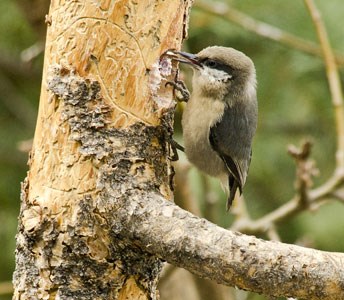
NPS Sitta pygmaeaLength: 3.5-4.3 in (9-11 cm) - Weight: 0.3-0.4 oz (9-11 g) General DescriptionThe Pygmy Nuthatch is a small bird with a slate-gray back and buffy underside. Males and females look the same, with white chins extending up just below the eyes and gray-brown caps. The edge of the cap is darker than the rest, giving the Pygmy Nuthatch a dark eye-line. Its bill is long and solid, and it has long toes and talons. The white on each side of its short tail can be seen in flight HabitatPygmy Nuthatches live almost exclusively in long-needled pine forests and are particularly closely associated with ponderosa pines. Look for them also in stands of other pines, including Jeffrey, Bishop, Coulter, Monterey, lodgepole, and Arizona white pine. Their typical forest habitat is open, park-like stands of older, large trees. They may occur in forests of pine mixed with oak, quaking aspen, maple, Douglas-fir, or white fir. Since they depend upon cavities in old trees (snags) for roosting and nesting, Pygmy Nuthatches are most abundant in forests that have escaped heavy logging and snag removal. BehaviorThese energetic songbirds forage by climbing pine trunks and branches to search under bark and in needle clusters for insects and seeds. They move constantly and give short, squeaky calls, often mixing with chickadees, kinglets, and other songbirds. Pygmy Nuthatches are highly social: they breed cooperatively and also pile in to cavities in groups to roost communally on cold winter nights. These flocks also forage with other species including warblers, chickadees, bushtits, kinglets, woodpeckers, and juncos. In cold weather they seek out well-insulated cavities to spend the night. Pairs roost together and juveniles roost with their parents as part of larger groups. Sometimes more than 150 individuals sleep in a single tree, stacked up in squares, triangles, diamonds, oblongs, or tiers of birds. They use controlled hypothermia to withstand cold winter nights, a strategy which no other North American bird species uses in combination with group-roosting in cavities. DietPygmy Nuthatches eat insects (and other invertebrates) and seeds. During the breeding season they eat mostly arthropods-including beetles, wasps, ants, bugs, caterpillars, and spiders-by probing cracks, scaling off loose bark, and gleaning from needle clusters and cones. In some locations their diet shifts to mostly pine seeds in the winter, while in others their winter diet resembles their breeding diet. Pygmy Nuthatches cache seeds year-round by hammering them into crevices or under flakes of bark on the tree, saving them for later. NestingThe male appears to take the lead in choosing a woodpecker hole or natural cavity as a nest site, usually in the trunk of a ponderosa pine or other long-needled pine, but sometimes in another conifer species or a quaking aspen. Pygmy Nuthatches nest in live trees, dead trees, dead parts of live trees, and nest boxes. Pygmy Nuthatches can excavate their own cavities, but often they just enlarge and adapt existing ones, creating irregular holes about 5-10 inches deep and 1-6 inches across. Both the male and the female, sometimes assisted by their offspring from previous years, help dig out the nest cavity and bring lining materials. In the bottom of the hole they build a nest cup of bark shreds, fine moss, grass, plant down, fur, wool, snakeskin, cocoons, and often feathers. They may also stuff similar materials in crevices within the cavity, helping to weatherproof the nest. The pair keeps lining the nest during egg-laying. Eggs & IncubationThe Pygmy Nuthatch eggs are generally white with brown markings. The female incubates four to eight eggs for 14 to 16 days. While she incubates, the male and the helpers bring her food. Male, female, and helpers all feed the nestlings and fledglings. Young birds fledge at 20 to 22 days and are partially dependent on adult birds for 23 to 28 days post-fledging. Pairs occasionally raise two broods a season, but one brood is the norm. Pygmy Nuthatches are cooperative breeders: about one third of breeding pairs get help raising their young from 1-3 male relatives. These are often the breeding pair's own sons from previous years; they help defend the nest and feed incubating females and chicks. To deter squirrels, Pygmy Nuthatches may sway threateningly from side to side or even cover the entrance with their bodies to make it less visible. Migration StatusThe Pygmy Nuthatch's are generally non-migratory but will move down in elevation in the winter. Interesting Facts
|
Last updated: May 4, 2018
